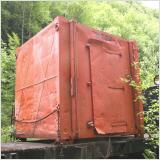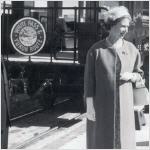1954 - 1982 The Container Route
White Pass ... Container Pioneers
White Pass ... Container Pioneers
..... Started System in 1955
"Containerization" is the big word in transportation these days. It's bandied around in articles, TV commercials and transportation circles, across Canada and the United States. Like computors, containerization has almost become a status symbol.
The White Pass build and tested its first container in 1955 nearly fourteen years ago, and it's been in the integrated ship-train-truck containerized transportation business ever since. In fact it's the first system of its type in the world, and also the biggest.
Container Tested
The first containers designed and build by the White Pass wouldn't meet today's standards. In fact the White Pass "test container" - the first one built - had "bugs". The doors became wedged against each other, and at the end of its first test trip they had to be opened with the aid of a cutting torch. The first load of freight selected to go north in the company's test container was rolls of building paper. It was deliberately selected because this commodity had always caused trouble when shipping by the old methods. More often than not they arrived flattened or creased. On the test run the rolls were stood up on end and the container locked, custom sealed and swung aboard ship.
On arrival at Whitehorse the container was greeted by a group of White Pass officials and an interested crowd of Yukon onlookers.
Then, disaster struck. The container doors wouldn't open. They were jammed shut. A torch was obtained and much advice from the crowd the doors were finally swung open.
There were the rolls of building paper, in perfect condition. The container concept was a success, even if the doors stuck.
Container Ship
In the meantime a White Pass container ship was under construction at Vickers shipyard in Montreal. It was the world's first.
By November 1955, containers and the ship were bought together and at 03.47 hours November 26, 1955 the brand new White Pass container ship "Clifford J. Rodgers" set sail for Skagway with her first load of "containerized freight". The new ship and containers, coupled with the upgraded and dieselized railroad and truck fleet made the Yukon the home of the first integrated container system in the world. The container concept has been at the Yukon service ever since.
In 1965 the "Rodgers" was sold and replaced with the 6000 ton MV Frank H. Brown, one of the world's most modern freighters. While the principle remained the same the containers and container handling equipment underwent drastic design changes.
Containers Improvement
While the early containers were only 8' x 8' x 7', holding some 5 tons of freight the new ones measured 25,3' x 8' x 8' and capable of holding 25 tons of freight. A marked improvement in carrying capacity and all round transportation efficiency.
Developing the containers was a natural outgrowth of a determination by White Pass management to reduce transportation costs in the face of continually rising prices. To meet the Yukon's transportation needs the containers concept had to meet seven major requirements.
1.) It had to provide transportation at the lowest possible cost by eliminating expensive and unnecessary freight handling.
2.) To help create a better northern environment, the proposed transportation system had to be capable of providing "southern-type" living by making it possible for Yukoners to obtain "southern-type" food and merchandise throughout the year.
3.) It had to provide adequate protection for perishable commodities against extreme winter and summer temperatures.
4.) It had to provide a system for transporting goods from Vancouver, across the Alaska Panhandle and into the Yukon territory with an absolute minimum of paperwork and inspections.
5.) It had to reduce breakage to a minimum and eliminate pilferage.
6.) It had to be capable of carrying anything from a pound of peanuts to thousand of tons of ore.
7.) It had to be capable of producing a return on capital invested - that is, earn a profit.
This was a tall order. None of the existing transportation systems could meet all these requirements, so the White Pass set to work and designed his own, in the process, made transportation history.
The modern White Pass 1200 cubic foot custom sealed containers come in four types, heater-freezer-vented and dry, each capable of holding 25 tons of freight. The heater and freezer containers are designed to hold their respective loads to a predetermined temperature.
The loaded containers are lifted aboard the MV Frank H. Brown, by a "Gantry" crane which is part of the 6.000 ton ship machinery.
Containers and heavy deck loads of northbound freight are exchanged at Skagway for a southbound containerized cargo of copper, asbestos and silver-lead-zinc concentrates.
Train & Truck - Final Link
Connecting with the White Pass ship at the railway which follows the original Klondike trail of '98 between Skagway and Whitehorse.
The final link in the integrated ship, train, truck transportation system is the White Pass Highway Division operating a modern fleet of trucks which fan out to all points in the Yukon.
The White Pass went into the transportation business at the turn of the century to serve the Klondike Gold Rush. In 69 years it has built a 110 mile railway into the most modern integrated containerized system of transportation in the world.
From "The White Pass" Container Route News March, 1969.


